Bokh: Discovering Mongolian Wrestling and Its Unique Style
Table of Contents
Bokh, or Mongolian wrestling, is a traditional sport that dates back thousands of years to ancient Mongolia. This style of traditional wrestling has withstood the test of time; from the days of Gengis Khan right up until the modern era, it has remained one of Mongolia’s most celebrated sports. Bokh is so well respected that it is considered one of the three essential skills of Mongolian culture, alongside archery and horse racing.
The sport emphasizes honor, respect, and tradition, with wrestlers following specific traditions and wearing traditional costumes. Although Bokh is relatively unknown in the western world compared to other grappling styles, it is still a very effective martial art. In this post, we will discuss Bokh, its ancient traditions, and its unique techniques.
History of Mongolian Wrestling
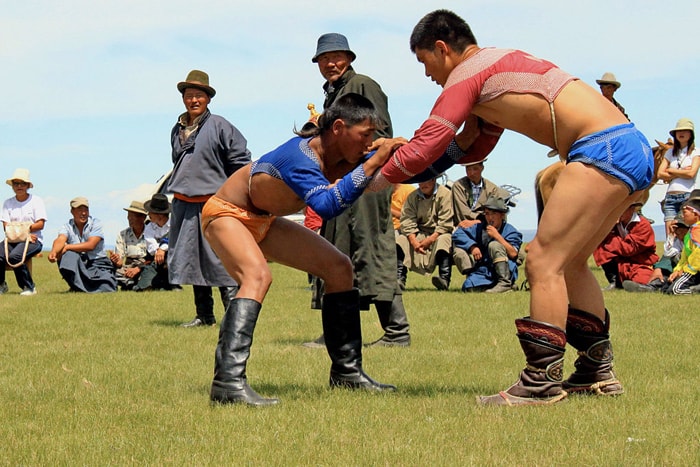
Origins of Bokh
Mongolian wrestling, or Bokh, is a folk wrestling style used by the Mongol people in Mongolia, Inner Mongolia, and other nearby regions. Bokh’s origins date back thousands of years, and it remains one of the best-preserved sports in Mongolia today. Its traditions are based on ancient customs and methods that were established centuries ago.
Cave paintings in Mongolia dating back to the Neolithic age show the grappling of two men surrounded by crowds. Not only do cave paintings point to Mongolian wrestling being an ancient sport, but so do historical texts. Let’s explore some of its history!
Ancient Mongolian wrestling in the Xiongnu Empire
The Xiongnu Empire, which existed from the 3rd century BCE to the 1st century CE, was a confederation of nomadic tribes in Central Asia. Artifacts from the Xiongnu Empire, including bronze plates, attest to the presence of wrestling in that civilization’s cultural practices.
Military training is believed to have used Mongolian wrestling to prepare soldiers for combat, but more than that, Bokh was an essential part of their culture and frequently featured in festivals and ceremonies. Wrestling also symbolized power and camaraderie among the Xiongnu people.
Over the centuries, Bokh evolved but retained its cultural heritage from the Xiongnu Empire, becoming a lasting legacy of the Xiongnu era.
Genghis Khan and the Mongol Empire
During the 13th century, under the leadership of Genghis Khan, the Mongol Empire expanded across much of Asia and Europe. Wrestling played a significant role in the lives of Mongol warriors within the Mongol Empire. It served as both a form of entertainment and a way to maintain physical fitness. Genghis Khan strongly supported Mongolian wrestling and believed it kept his soldiers battle-ready.
For the Mongols, wrestling was an art form that demonstrated their power, agility, and leadership. During festivities or important events, it was customary for Mongol chiefs to participate in wrestling matches. It was also a way to create bonds and friendships between people, as wrestling is known for developing camaraderie.
Most importantly, Bokh served as a means of training and honing combat abilities for Mongol warriors within the bigger picture of Mongol society. The Mongols’ military might and social fabric depended on cultural events, and wrestling was a huge part of it. It was a revered sport that personified virtues like courage, perseverance, and strategy. This means displaying it at festivals like the Naadam, which was believed to encourage and strengthen the Mongol Empire.
Wrestling in Mongolia had both practical and symbolic meaning for the Mongols, and Genghis Khan and his contemporaries placed a high value on it.
Mongolian Wrestling in the Modern Era
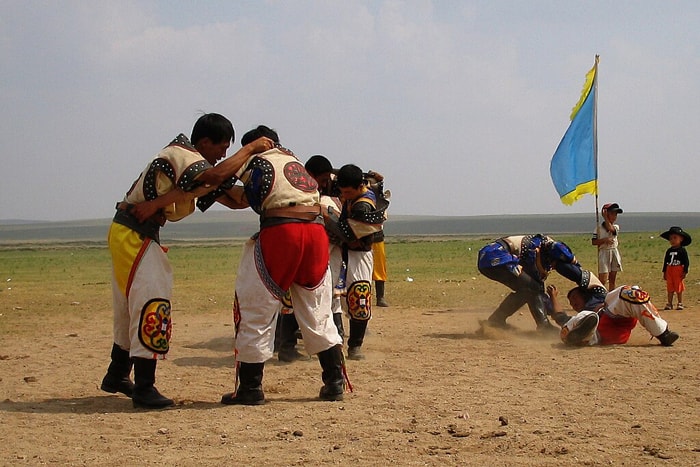
Mongolian wrestling has evolved from a traditional sport practiced in celebrations and in the military to the most popular national sport. Various formal and informal wrestling competitions highlight the significance of wrestling in Mongolian culture. This is partly due to wrestling’s formalization and institutionalization during the Soviet era. During this period, the Mongolian Wrestling Federation established a structured competition system, which made wrestlers aspire to compete more often and win championships.
The Naadam Festival, a major cultural sporting event in Mongolia, also played a huge part in bringing Bokh successfully into the modern era. Although the Naadam is an ancient festival that hosts sporting events, its popularity has remained very strong in the modern era. Mongolian wrestling in particular played a major role in keeping interest in the Naadam festival, and its competitive nature remains strong in modern times.
The Traditional Mongolian Wrestling Outfit
Zodog, Shuudag, and Gutal: The Importance of Attire
The standard attire of a Mongolian wrestler includes a Zodog, a tight, collarless, heavy-duty short-sleeved jacket that is usually red or blue. Knotted string is used to secure it at the back, and the wrestler’s chest is exposed at the top.
Shuudag, a type of small, tight-fitting briefs made of red or blue cotton fabric, serves as the wrestler’s covering and increases mobility.
Mongolian wrestlers also wear traditional leather boots called Gutal. These are meticulously handcrafted, can take up to a month to make, and are another crucial element of the Mongolian wrestling attire.
The unique clothing of Mongolian wrestlers is designed to ensure comfort and practicality during a wrestling match while also being a tribute to the traditions of the martial art.
Major Competitions and Tournaments
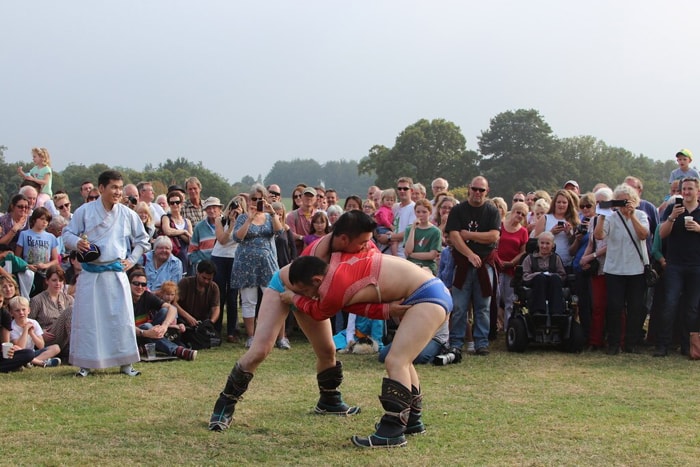
The Naadam Festival: A Celebration of Mongolian Culture
The Naadam Festival is a cultural sporting event with long historical ties to the Mongol empire and represents one of the nation’s most significant celebrations. Naadam translates to games in English. This festival features the “Three Manly Games” of their culture: archery, horse racing, and wrestling. It is a way to celebrate Mongolian heritage and sport.
Since the earliest days of the Mongol Empire, the Naadam festival has served both as an entertainment and cultural event for Mongolia. It was originally a festival where Genghis Khan’s warriors could show off their talents and celebrate their military might. Today, it is a hugely popular sporting and cultural event, with Mongols from all over the country flocking to enjoy their culture.
The Mongol emperors established the festival as a formal event to strengthen cultural bonds and solidarity, and these traditions have persisted in modern-day Mongolia. Today, this festival takes place annually from July 11–13. The Naadam festival is a crucial event for preserving Mongolian traditional wrestling.
Danshig Naadam, Altargan, and Other Tournaments
Danshig Naadams are smaller-scale tournaments than the national Naadam festival. Although the Danshig Naadam is smaller, it is still a large cultural event in Mongolia and holds all kinds of sports and traditions. They are organized once a year or so in the countryside to celebrate specific anniversaries of provinces or historic locations.
The Altargana is a festival celebrated by Buryat Mongols with their own wrestling style. It is a smaller festival than the Danshig Naadam but still holds various cultural events and sports such as wrestling.
Mongolian wrestling is such a huge sport in Mongolia that there are various other small tournaments around the country. Although the main goal of Mongolian wrestlers is to compete in the Naadam Festival, a number of other wrestling tournaments still take place year-round.
Rules and Match Courtesy
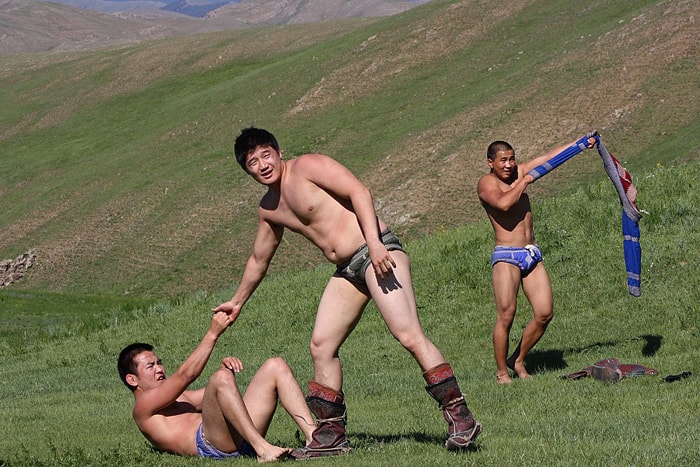
Zasuul: The Art of Starting a Match
Wrestlers often have a “fixer” or “Zasuul” who acts as their coach and guide while they compete. As his wrestler competes, Zasuul is to cheer him on and offer words of encouragement while holding his hat.
Each match has two Zasuul’s; although a Zasuul is similar to a referee, they are not exactly a referee. They are present to ensure traditions, spot illegal moves, and enforce the rules. They do not have favorites, and essentially, their job is to look out for foul play and make sure the Mongolian wrestling traditions are respected.
Leg Contact, Kicking, and Falls: Understanding the Match Rules
Mongolian wrestling has specific rules that distinguish it from other styles of wrestling. Below are some of the main rules of a Mongolian wrestling match:
- Aim to get your opponent to touch the ground with his upper body, knees, and elbows.
- If any part of the body other than the wrestler’s feet touches the ground, the match will result in a defeat.
- Inner Mongolian rules don’t allow grabbing the leg, but Mongolian rules allow grabbing the leg.
- Inner Mongolia has a time limit to the matches, while Mongolia has no time limit.
- There are no weight divisions or size limitations in Mongolian wrestling.
- Each wrestler wrestles once per round, with the winner moving on to the next round and the loser being eliminated from the competition.
This unique ruleset of Mongolian wrestling makes it interesting to watch, as some unfair elements do exist in the rules. Unlike other grappling martial arts, in Bokh wrestlers have to overcome larger and more experienced opponents. Although Inner Mongolian wrestlers go by slightly different rules, they are both essentially the same sport.
The Spirit of Sportsmanship: Fair Play and Respect
The principles of fair play and respect are taught to aspiring Mongolian wrestlers from the very beginning of their wrestling career. Off the mat and in life, coaches and elders will often stress the value of honesty, modesty, and honor.
The presence of the Zasuul also ensures that rules and proper etiquette are followed by the wrestlers. Mongolian wrestling is a respectful sport with many humble competitors; showboating and taunting aren’t accepted, and the overall character of the sport is one of humility.
Training and Techniques
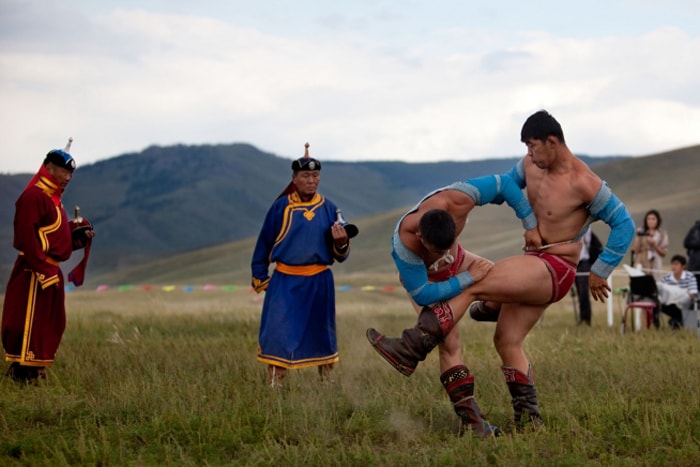
Mastering the Art of Bokh: Training and Practice
In preparation for the summer Naadam festivals, most of the wrestlers usually go to a training camp in the countryside where they set up their yurts or visit a family that has trained in their spot for years.
As the Naadam is one of Mongolia’s biggest cultural and sporting events, winning at the festival is the main goal of many Mongolian wrestlers. This is the usual way that wrestlers get ready:
Strength and conditioning: To increase their flexibility, stamina, and strength, wrestlers undergo intense strength and conditioning workouts. This includes conventional forms of physical training, such as running, wrestling, and lifting heavy stones. They also target more modern areas of strength and conditioning, like weightlifting and core strength training. All of this is done to achieve maximum strength and maneuverability when wrestling.
Techniques and strategies: The art of Mongolian wrestling is characterized by its precise throws, holds, and maneuvers. In order to perfect their techniques, wrestlers frequently practice these techniques with their training partners.
Nutrition and diet: Wrestlers must give special attention to their eating habits. To fuel their rigorous workouts, they eat a diet rich in protein sources like meat and dairy, as well as carbs and veggies.
Mental preparation: It is crucial to be psychologically prepared. Mental training helps wrestlers focus, gain confidence, and be more resilient. They may practice tactics for dealing with competition stress by visualizing matches.
Cultural practices: As part of their training, wrestlers also take part in ceremonial practices and rituals. Offerings and prayers can be part of these to bring strength and good fortune to the celebration. A crucial part of their preparation is honoring tradition and cultural practices.
Help from Coaches, Family, and the Community: Getting ready usually requires help from coaches, family, and the community. Traditional Mongolian wrestling places a premium on a wrestler’s network of friends and family.
Various Techniques Used in Mongolian Wrestling
Although Mongolian wrestling has a different ruleset than most other types of grappling, the techniques are still vast and complex. There are around 40 base techniques known as mekh, and all of these have variations. This makes Bokh a very complex martial art when diving deep into its list of techniques. Some of the most commonly used techniques in Mongolian wrestling are:
- Khutul – This is a powerful throw where the wrestler uses their opponent’s momentum to lift and throw them to the ground.
- Zaslan – In this technique, a wrestler uses a sweeping motion with their legs to destabilize and throw the opponent.
- Nokhor – Gripping the opponent’s arm or shoulder, the wrestler uses it to control their movement and set up a throw. This technique resembles the Japanese martial art of Judo.
- Sakhan – Focusing on leverage and balance, the wrestler aims at twisting or pivoting to bring their opponent down.
- Bukhari – Using a low center of gravity and strong leg movements, the wrestler lifts and throws their opponent.
- Huch – This technique focuses on powerful, direct force to unbalance and bring down the opponent.
- Tsam – Sudden, sharp movements are aimed at catching an opponent off guard and achieving a quick throw.
- Bayarlah – The wrestler uses a combination of upper-body strength and leg positioning to gain control and throw the opponent.
Mongolian wrestling techniques are vast, and they have influenced international grappling competitions, including freestyle wrestling and Greco-Roman wrestling. These are just a few of the techniques involved in this complex martial art.
Conclusion
Mongolian wrestling is an example of how traditional martial arts styles can still thrive in modern times. While Mongolian wrestling is by no means world-famous like Brazilian Jiu-Jitsu, it is becoming more and more recognized in the martial arts world.
The sport is a symbol of strength, courage, and national pride, and most importantly, it is a huge part of Mongolian culture.









